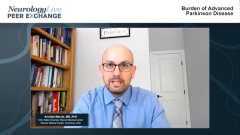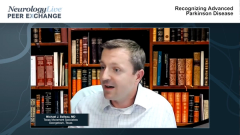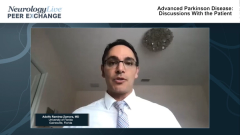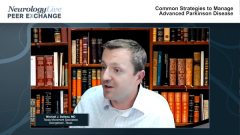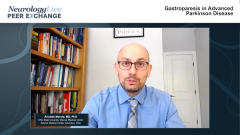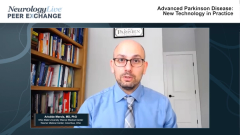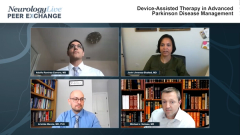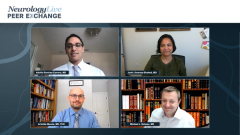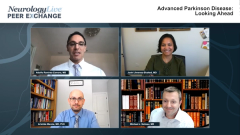
Discussing Device-Assisted Therapy in Advanced Parkinson Disease
An advanced Parkinson disease expert explains how to discuss the different device-assisted therapy options with patients.
Episodes in this series

Adolfo Ramirez-Zamora, MD: I’m going to ask Ari to speak. Maybe you can talk briefly about that discussion, how that discussion takes place in Columbus [Ohio] at your center [Wexner Medical Center], and how you go by the different options these days. How do you approach the patient and say, “Hey, listen, I have vanilla, strawberry, and chocolate, which 1 do you like? How are you going to take it?” How do you do that? It’s not an easy task.
Aristide Merola, MD, PhD: I totally agree with what was said before. The interesting thing is sometimes what’s happening is actually the opposite. Patients reach out to us with 1 idea, and after talking with us they end up choosing another option. This is the case of focused ultrasound ablation, for instance. There is this new therapy that basically allows for controlling tremors. It’s considered a noninvasive therapy because it doesn’t really require actual brain surgery. We realize that many patients come to us because they want to do something more interventional and discuss the focused ultrasound. Later, after we discuss all the pros and cons of every option, they end up understanding that maybe deep-brain stimulation [DBS] is a better fit for them. But they would have never come [to us] if it weren’t for the focused ultrasound. It’s not only in our center. I spoke with other colleagues who told me it’s the same trend a little bit everywhere.
The other point is when to use a device such as an infusion pump or an implantable device. If you use an infusion pump it can be an enteral infusion pump, or a subcutaneous infusion pump. It’s something that doesn’t require much effort because it’s a very small procedure, just a subcutaneous injection that can be performed by the patient, but it requires some commitment every day. If you go with an implantable device, such as deep-brain stimulation, after the 1 surgical procedure, you don’t have to worry anymore because basically the device works in background and nothing else is required on your end. When patients understand that instead of taking 20 or 30 pills per day, they can basically have a normal quality of life, maybe taking just 3 or 4 pills a day, they see the advantages of this.
Another important point is new therapies coming out, such as gene therapy. Gene therapy is only experimental, but it’s going toward a point of understanding when to intervene. The first gene therapy trials were done on patients with 10, 15 years of Parkinson disease. Of course, once you add gene therapy in a brain that has already been suffering for 10, 15 years from a neurodegenerative process, the possibility of changing is very limited. Now the thinking is if we want to use gene therapy, the earlier the better, especially if we go with neurotrophic factors or other approaches that may have a potential for neuroprotection. It’s not an easy conversation talking with people who only have 2, 3 years of Parkinson disease and talking about neurosurgical procedures such as gene therapy. It’s changing very rapidly.
Adolfo Ramirez-Zamora, MD: Great comments. Joohi, how do you present these options to the patients? Do you also talk about the different neurostimulators available on the market when you discuss DBS? For the longest time, we had only 1 company that dominated the market for neuromodulators or neurostimulators, but then in recent years 2 other companies have available and approved devices with some differences among them. Now patients are educated, they read about this, and they also get to provide input. How do you navigate that? When you’re talking about advanced therapies from the DBS providers and potentially using subcutaneous levodopa in clinical trials, or duodenal infusion as an alternative, how will you go about it?
Joohi Jimenez-Shahed, MD: It’s a challenging landscape, and we’re fortunate to be in this situation with so many choices available. That’s great news, not only for us as practitioners because we have more to offer the patient, but also for the patients because they can choose from almost a menu of options for how they want to proceed. To address your deep-brain stimulation question, yes, there are 3 manufacturers that have different devices on the market. Each has different bells and whistles, but in the end, they’re fundamentally all going to do the same thing, which is to help patients with their motor fluctuations. We’ve seen time and again in the clinical trials for these devices that they reduce the OFF time. There’s a corresponding increase in the ON time—not only ON time, but ON time without troublesome dyskinesia, so we can definitely see an antidyskinetic effect from stimulation.
For the most part, there are opportunities for patients to be able to reduce the number of medications they take, and that’s going to hold true regardless of which device is used. I always start with that preface to my patient. Yes, there are going to be different devices. They all do, in the end, the same thing, but they have different bells and whistles that might have certain features or advantages that are in particular more applicable to their case, or maybe their physician has more familiarity with or prefers 1 or the other. It doesn’t have to feel like you’re sacrificing some type of symptom control because you chose a certain device over another. They’re all going to work, and as long as you have a good practitioner who knows how to program these devices well, and you have a good surgeon who can put the electrode in the right place, then you’re good to go. I lay it out like that. I give all my patients information from all the different device manufacturers, and I let them read about it and understand. I try to answer their questions about what’s different about the devices, and then ultimately, we come to a decision about which 1 is the most suitable for them.
There are other nuances: whether they have rechargeables, whether the patient wants a rechargeable, that they have a direction. You can certainly get into those weeds. Some patients want to consume all that information and understand it and really choose. Others say, “Doc, tell me what you want, and I’ll do it.” You can tailor your conversation according to whom you’re dealing with. Along with just the information about those options for deep-brain stimulation, you mentioned that there are these different devices. We have the deep-brain stimulator, we have the infusions, we have clinical trials of newer agents. I share that information with patients, and I tell them what the differences are. With the pumps there’s different hardware that they have to think about, there are different requirements in terms of maintaining that therapy and engaging with that therapy. With the research trials obviously, there are a host of other considerations in terms of participating in the trial, and patients may have different preferences for different reasons.
Adolfo Ramirez-Zamora, MD: Thank you all for watching this Neurology Live® Peer Exchange. If you enjoyed the content, please subscribe to our e-newsletter to receive upcoming Peer Exchanges and other great content right in your in-box. Thank you so much.
Transcript edited for clarity.
Newsletter
Keep your finger on the pulse of neurology—subscribe to NeurologyLive for expert interviews, new data, and breakthrough treatment updates.

